
 |
Previous | SkunkHaven.Net Index | Next |
| Page 1 | Page 2 | Page 3 | Page 4 | Page 5 | Page 6 | Page 7 | Page 8 | Page 9 | Page 10 |
Skunks sometimes suffer excessively from bite wounds, infection can easily set in in their fatty tissues. Check for bite wounds often, other animals' and even self-inflicted bites can turn severe in a short time.
Skunks can develop more than one bacteria in the wound and NOT all antibiotic's will work on all infections. One bacteria could clear up and another may set in, it is best to culture several times if the infection is not clearing up.
For infected wounds:
We have had good success with Cipro (Ciprofloxacin HCL) treating various infections - consult your vet for more information. Be aware of the precautions when using Cipro, discontinue calcium suppliments and avoid direct sunlight when using Cipro.
We are using Colloidal Silver 30 to treat minor bite wounds.
Topical cleaning with hydrogen peroxide generally is not done for more than a day as the peroxide breaks cells and slows the healing process, although it is a great cleaner at time of initial start of topical therapy. Peroxide should never be used internally, therefore flushing of wounds with peroxide is not recommended.
Progression and treatment of severe infection from bite wound -
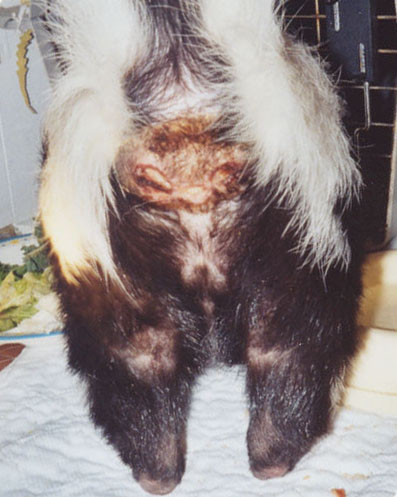 |
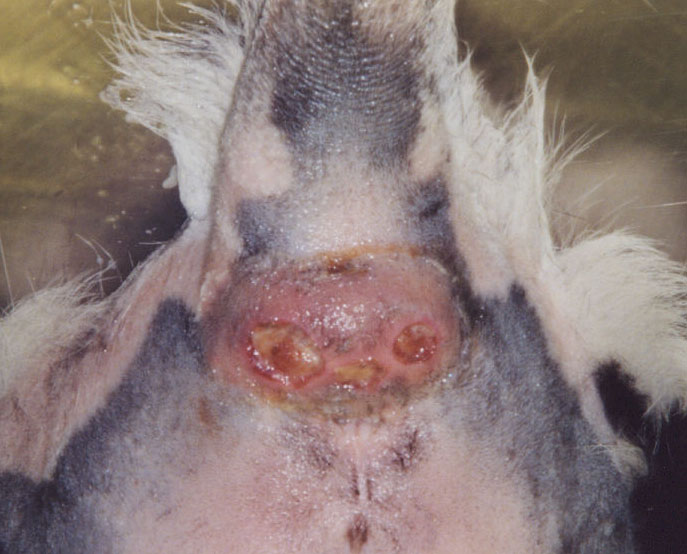 |
| Eight Days After Bite - Infection Not Responding to Treatment | Twelve Days After Bite - Prep'ed for Surgery |
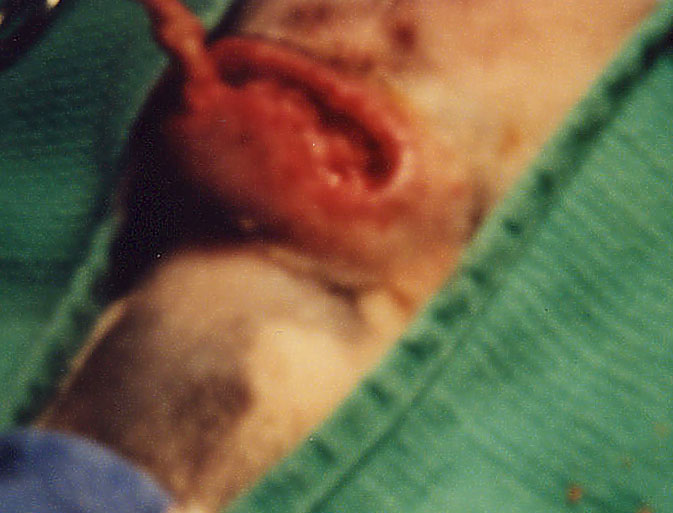 |
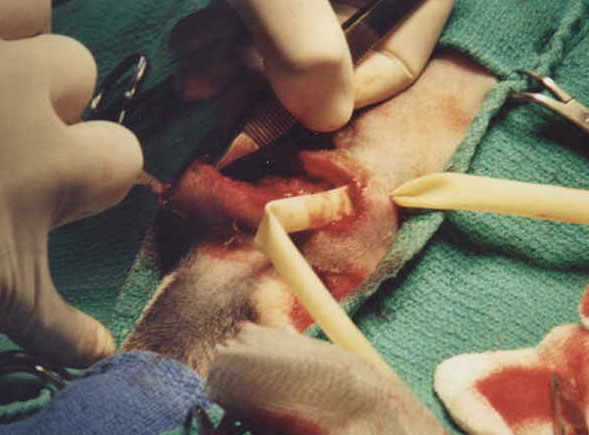 |
| Clearing the Infection | Inserting a Drain Tube |
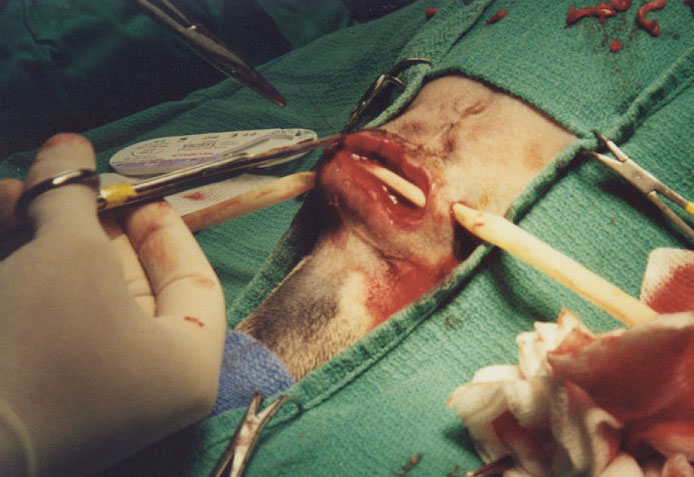 |
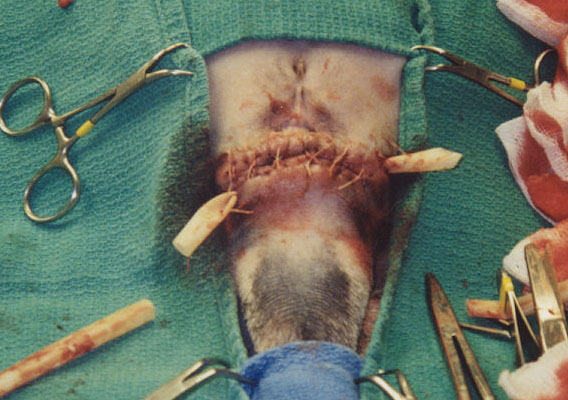 |
| Closing the Incision | Finished Surgery |
| This sequence of photos indicates a "worst case" in bite wounds on a skunk. Typical antibiotic treatments were unsuccessful at eliminating the type of infection and the infection spread through the fatty tissues in the skunk's hind quarters.
Approximately three tablespoons of infected flesh were removed during the surgery, a drainage tube was inserted, and the incision closed. The drainage tube was removed two days after the initial surgery. The placement of the wound, close to the anus, added to the difficulty and possible post-op problems in this case. The tissues were analyzed and determined to be infected by Pseudomonas aeruginosa which is resistant to many antibiotic treatments. Baytril (Enrofloxacin) was successful in halting the spread of infection, given 1 cc dose twice per day over the course of two weeks. Baytril was a last resort choice due to the possibility of side effects including liver damage. |
|
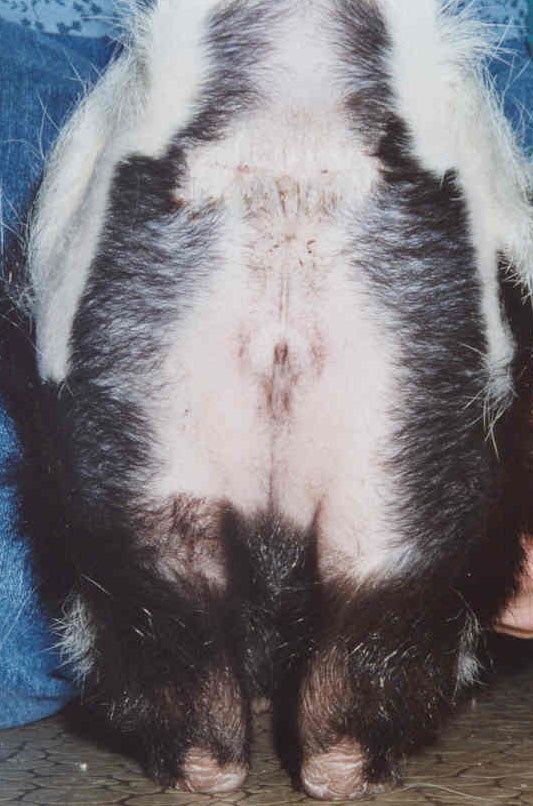 |
|
| Three Weeks After Surgery | |
During the mating season males, even neutered males, should be kept seperate from females. The following pictures show excessive bite wounds on a female skunk done by a male skunk.
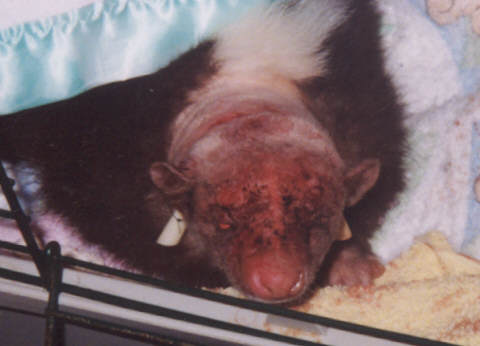 |
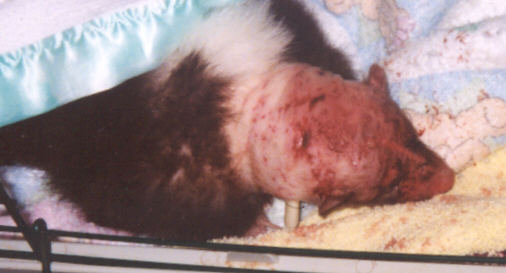 |
| Day After | Day After |
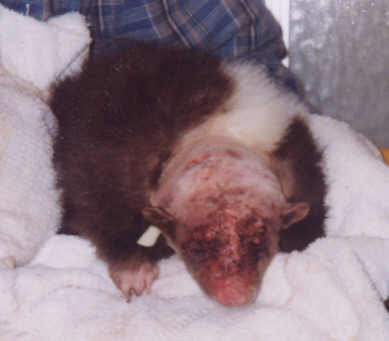 |
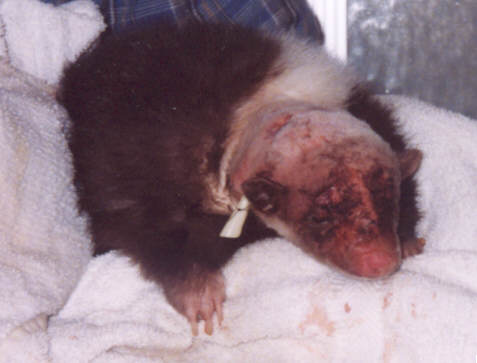 |
| Three Days After | Three Days After |
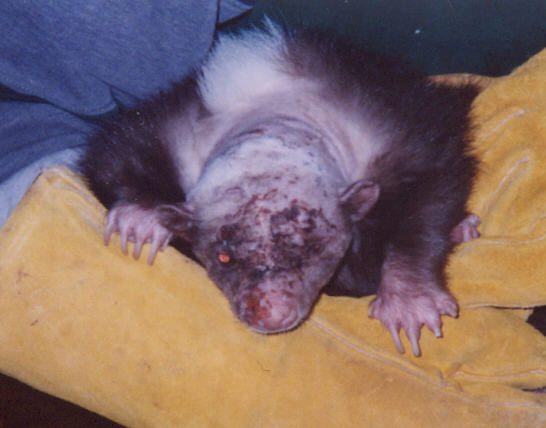 |
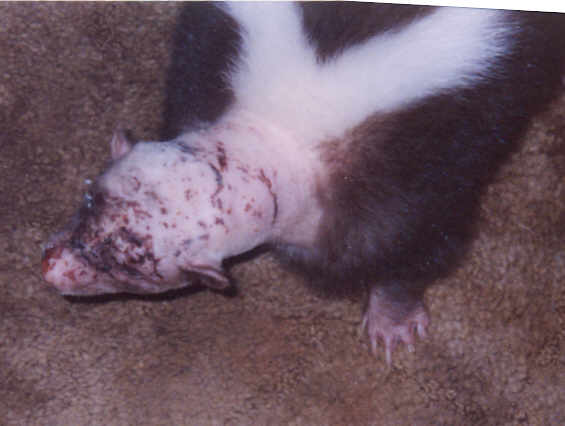 |
| Ten Days After | Ten Days After |
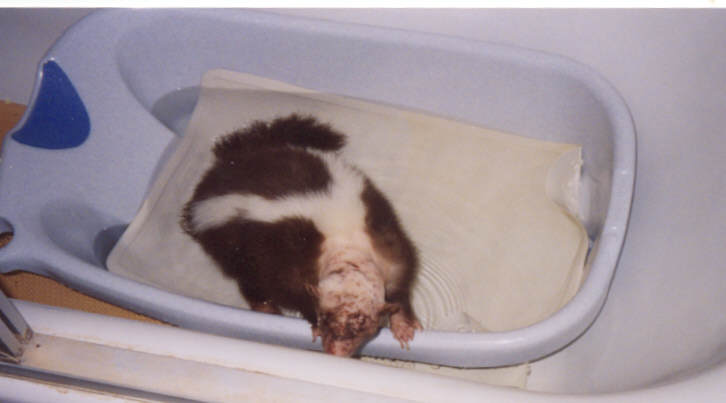 |
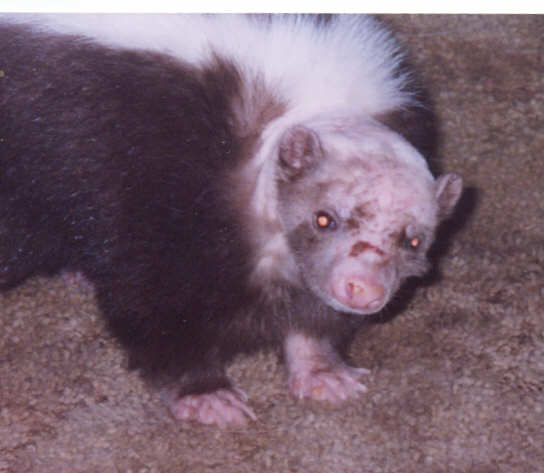 |
| Epsom Salts Bath | Three Weeks After |
Wounds must be treated as soon as possible to prevent (more) severe infection. Skunks have a lot of avascular tissues, usually fatty tissues, and infections can grow and spread quickly. Treatment by a veterinarian or someone skilled in animal care is very important, waiting for redness and swelling to set in could lead to more costly treatment and/or death to your skunk. Even a minor wound should be treated with an antibiotic and monitored over several days to ensure that the wound is healing properly.
Often wounds will require treatment several times per day for two or more weeks. Cleansing the wound and applying antibioics must be done regularly and consistantly until the wound is healed.
Cleaning and flushing the infected areas can be done with Betadine or Nolvasan antibiotic solution obtained from a vet, we have used both with success.
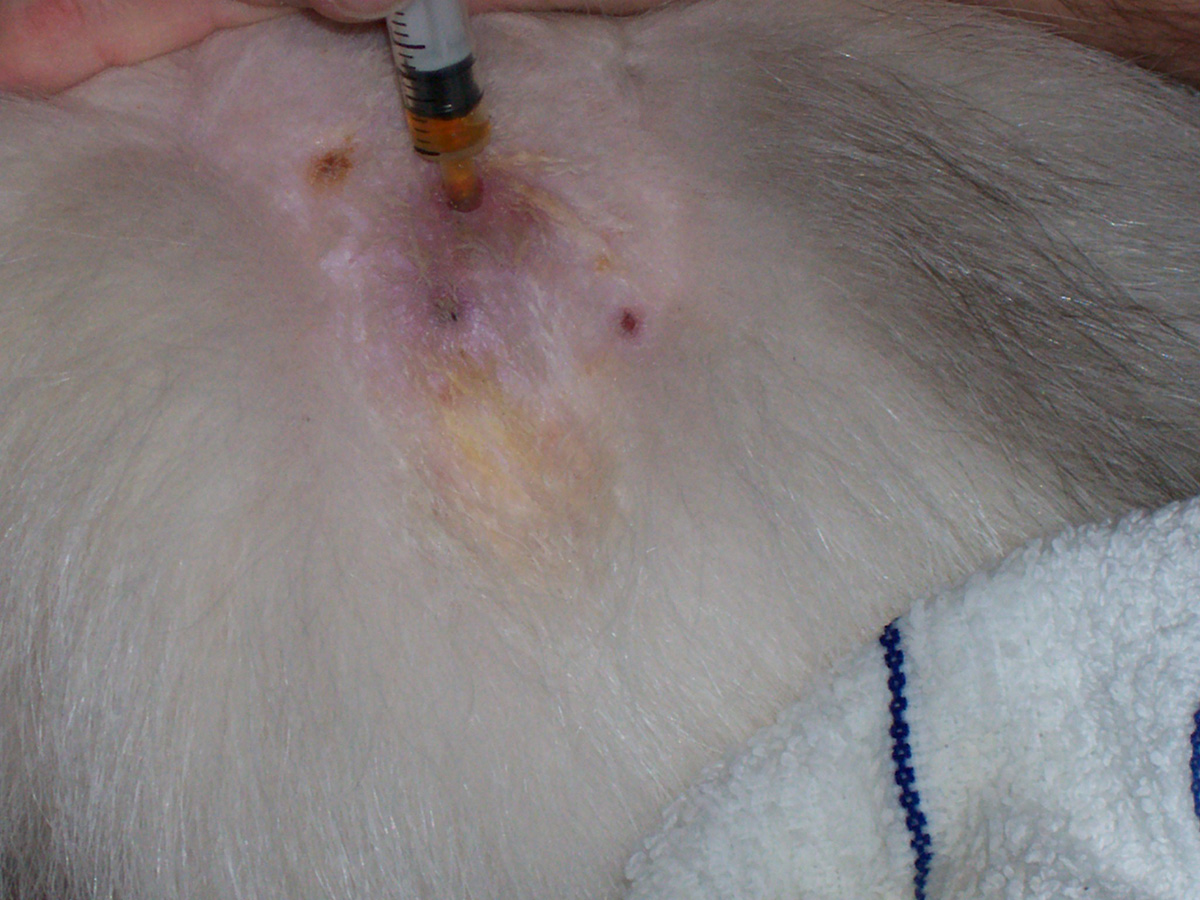 | 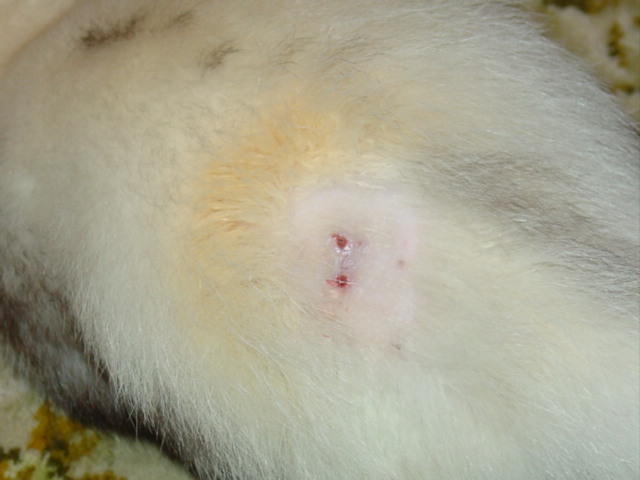 |
| Cleaning a bite wound with Betadine solution. | After two weeks. |
| Video Clip showing how to flush a wound. | Photos by Tanya |
This study was run to help better understand the pathologic bacteria found from 2 bite wound cultures. In one case both Pseudomonas aeruginosa and Streptococcus Group G were cultured and thought to be the bacteria causing infection at the site of bite wounds. In this first case a negative growth was noted in the anaerobic culture plate. In a second bite wound culture case only Pseudomonas aeruginosa was cultured.
In our study we ran aerobic identification cultures only on 7 different skunks. The skunks were from 2 different populations. Samples were collected during general anesthesia at time of surgical sterilization. Sterile swabs were used to collect the samples and then were stored in gel to promote bacterial growth during storage. An independent laboratory set up samples within 24 hours of collection time. Sampling technique involved rubbing the sterile swab in the cheek areas and along the teeth.
| Aerobic oral bacterial flora cultures from domestic skunks | ||||||
| The terms rare, light, moderate, and heavy indicate relative amounts of growth of the indicated bacteria. | ||||||
| Pop. | Subj. | Pseudomonas aeruginosa | Staphylococcus coagulase neg | Escherichia coli | Streptococcus alpha-hemolytic | Proteus mirabilis |
|---|---|---|---|---|---|---|
| A | 1 | moderate | moderate | |||
| A | 2 | moderate | moderate | |||
| A | 3 | moderate | moderate | rare | ||
| B | 1 | rare | ||||
| B | 2 | light | ||||
| B | 3 | heavy | ||||
| B | 4 | moderate | rare | moderate | ||
This study was conducted to help understand the oral bacterial flora of the domestic skunk as pertaining to bite wound abscess formations in cage mates that had been attacked. Sensitivity patterns were not determined at this time as it's relevance to therapy would be minimal as culture and sensitivity will vary on a case by case basis.
It is this author's opinion that oral bacteria injected through the skin via tooth puncture can lead to serious and possibly fatal infections. The subcutaneous fat layer found in a skunk is fairly avascular and limits antibiotic penetration through the blood stream. Appropriate antibiotic use based on culture and sensitivity as well as good surgical drainage and wound management is a must to stack the odds in favor of complete recovery.
Further studies to evaluate the anaerobic bacteria flora would help to better understand the true normal oral bacteria flora of a skunk. Some have also considered normal skin culture evaluation as the injection of the bacteria, although mechanically performed by the teeth, could in fact transfer bacteria from the skin surface into the fatty subcutaneous layer.
The date and opinions of this paper are original work presented by
Dr. Frank Krupka at the Avon Lake Animal Clinic.
Dr. Krupka did a case study on six skunks. A swab culture was done by sticking the swab in each nose. The swab was then sent to Pet Labs for analysis.
| NORMAL | Coagulase negative Staphylococcus |
| ABNORMAL |
1. Clostridium perfringens 2. Enterococcus sp 3. Alcaligenes xylosoxidans (very rare) 4. Staph 5. Aureus mrsa 6. Pasteurella multocida |
© 2005-2012 Skunk Haven™ Skunk Rescue, Shelter, and Education, Inc.
Revised 02/29/12 (SRS)
 |
||
| Previous | SkunkHaven.Net Index | Next |
|
|
Validate HTML 4.01 |